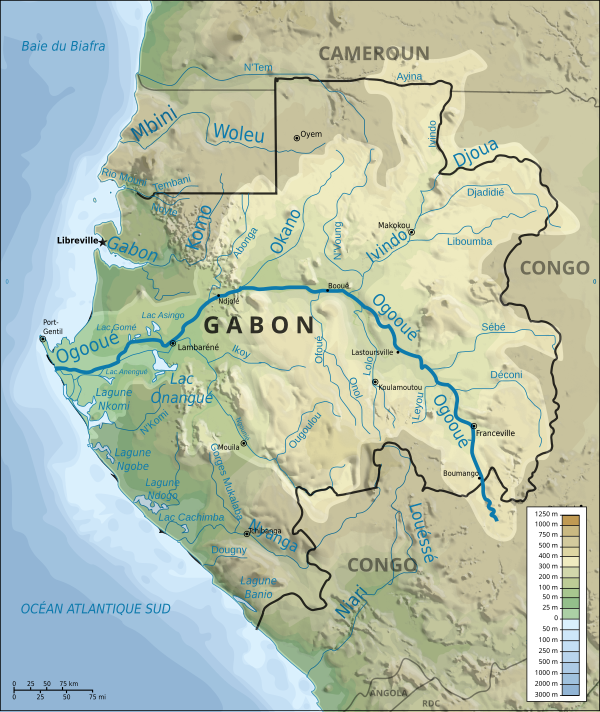Top Qs
Timeline
Chat
Perspective
Ogooué River
River in Gabon, Africa From Wikipedia, the free encyclopedia
Remove ads
The Ogooué (or Ogowe), also known as the Nazareth River, some 1,200 km (750 mi) long, is the principal river of Gabon in west-central Africa and the fourth largest river in Africa by volume of discharge, trailing only the Congo, Kasai and Niger. Its watershed drains nearly the entire country of Gabon, with some tributaries reaching into the Republic of the Congo, Cameroon, and Equatorial Guinea.[5]
Remove ads
Geography
Summarize
Perspective
Course
The source of the Ogooué River was discovered in 1894 by Mary Kingsley, an English explorer who travelled up the banks by steamboat and canoe.[citation needed] The river rises in the northwest of the Bateke Plateaux near Kengue, Republic of Congo.[5] It runs northwest, and enters Gabon near Boumango. Poubara Falls are near Maulongo. From Lastoursville up to Ndjole, the Ogooué is non-navigable due to rapids. From the latter city, it runs west, and enters the Gulf of Guinea near Ozouri, south of Port Gentil. The Ogowe Delta is quite large, about 100 km long and 100 km wide.
Delta
A 30,000 ha site in the delta of the Ogooué River, including much of Mandji Island, has been designated an Important Bird Area (IBA) by BirdLife International because it supports significant populations of many bird species.[6]
Basin
The Ogooué Basin is 223,000 km2 (86,000 mi2), of which 189,500 km2 (73,200 mi2) or 85 percent lies within Gabon.[7]
Ogooué River Basin area by country:[7]
Distance from river mouth:[8]
*River in confluence
Gauging stations along the Ogooué River:[2]
Remove ads
Discharge
Summarize
Perspective
Remove ads
Tributaries
Summarize
Perspective


The Ogowe River receives water of numerous tributaries including:
- Abanga, which rises in the Cristal Mountains, near Medouneu
- Baniaka
- Dilo
- Iyinda, the most important tributary
- Letili
- Lassio
- Lebombi
- Lekabi
- Lekedi
- Lekoni, which flows across Akieni and Leconi
- Letili
- Leyou
- Lolo
- Mbine
- Ngolo
- Ngounie
- Nke
- Offoue
- Okano, whose main tributary is the Lara River
- Mpassa, which flows across Franceville
- Sebe, which flows past Okondja
- Wagny
Remove ads
Ecology
It mostly consists of undisturbed rainforest with some savanna grassland where the mid-year dry season is longest. It is home to a high biodiversity. All three species of African crocodile, for instance, occur in the river: the Nile crocodile, the dwarf crocodile, and the slender-snouted crocodile. It is also the type locality for the catfish Synodontis acanthoperca.[16]
Economy
The Ogooué is navigable from Ndjole to the sea. It is used to bring wood to the Port Gentil Harbour.
The Ogowe Basin includes several major conservation reserves, including Lope National Park.
The catchment area has an average population density of 4 people per km². Towns along the river include Ayem, Adané, Loanda, Lambaréné, Ndjole, Booué, Kankan, Maulongo, Mboungou-Mbadouma, Ndoro, Lastoursville, Moanda, and Franceville near the Congo border.
Towns in Congo include Zanaga.
The first European explorer to trace the river to its source was Pierre Savorgnan de Brazza, who traveled in the area in the 1870s.[5]
Remove ads
References
External links
Wikiwand - on
Seamless Wikipedia browsing. On steroids.
Remove ads


